Archive for November, 2014
November 30th, 2014 by dave dorsey
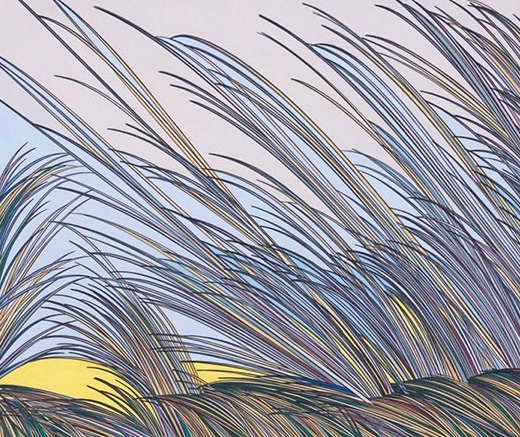
The Path 28, Bill Santelli, prismacolor on paper
About a month ago, I spent a couple hours at our Barnes & Noble’s Starbucks here in Pittsford talking with Bill Santelli, a local artist about my age who is also represented at Oxford Gallery; he does some fantastic abstracts and sells more work than most artists I know, including me. We got onto the subject of being “an artist” as opposed to simply being a painter. I told him I’ve never wanted to be “an artist”; I just want to paint. The idea of being famous or having some recognized role in the “art world,” either as a painter or a writer, feels odd, maybe even a little uncomfortable. I like the feeling of producing satisfying work, but I feel at home in a sort of creative isolation, for some of the same reasons I avoided getting a degree in fine arts. I want to pick my influences. I still distrust much of what’s considered interesting now in the art world, as I was decades ago, and I belong to the school of thought that people become what they behold, or at least MORE
November 17th, 2014 by dave dorsey
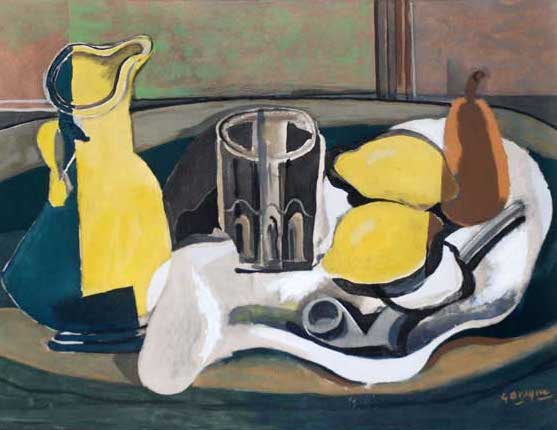
Still Life with Lemons, George Braque
Over the past year, more and more, I’ve been involuntarily daydreaming as I paint, in a way that reminds me of what Gaston Bachelard talks about in The Poetics of Space. It’s an idiosyncratic book, beautifully evocative and almost impossible to classify, though it’s often considered a work of philosophy because of its approach to something that sounds absurdly limited: what happens psychologically and emotionally when a person encounters certain kinds of space. It explores how people experience rooms, forests, shells, corners, closets, drawers—and how different the shapes and volumes of these spaces evoke entirely different kinds of dreams. For him, various environments relate in specific ways to the human body and the way people actually inhabit or employ different spaces comes to take on multiple meanings. For him, space is essentially a state of mind rather than the staging area for travel and physical measurement. As Bachelard says in his introduction, the phenomenological approach of the book requires the reader to simply pay attention to how the experience of space can enlarge an individual’s receptivity to new imagery. He puts aside any inherited philosophical or psychological theories and simply examines what’s happening, in human terms, by paying attention to this own encounters with space and how it opens up a state of reverie, a daydream. Different shapes and sizes of space unlock different kinds of dreaming, a treasury of moods, feelings, and mental images. I think what he’s actually doing is elucidating how poetry and painting evoke a sense of a world.
As you read the book it inspires the kind of daydreaming he refers to MORE
November 14th, 2014 by dave dorsey
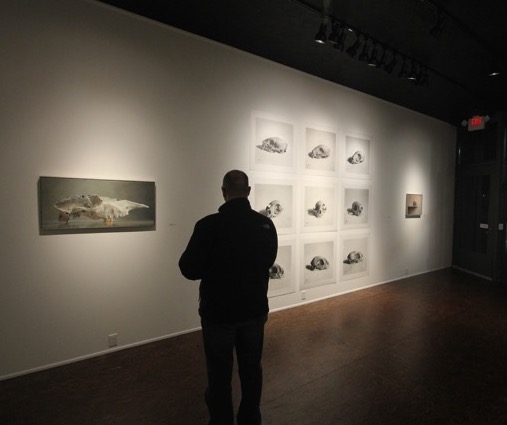 A three-part show about the human and animal body (heads, arms and legs, and skulls) opened at Manifest–I wrote about it two posts ago–and this remarkable gallery in Cincinnati drew 293 people to the reception. (The email from Manifest to participants was specific about the number, didn’t round it up to “around 300”, which is testimony to the integrity of this gallery and its programs.) Even without the upward rounding, that’s quite a turnout, for any gallery, anywhere. I couldn’t be happier to have a painting in the show, and I have pictures of how it looks (above, for example) thanks to the team at Manifest, who sent shots to all the artists chosen for the shows.
A three-part show about the human and animal body (heads, arms and legs, and skulls) opened at Manifest–I wrote about it two posts ago–and this remarkable gallery in Cincinnati drew 293 people to the reception. (The email from Manifest to participants was specific about the number, didn’t round it up to “around 300”, which is testimony to the integrity of this gallery and its programs.) Even without the upward rounding, that’s quite a turnout, for any gallery, anywhere. I couldn’t be happier to have a painting in the show, and I have pictures of how it looks (above, for example) thanks to the team at Manifest, who sent shots to all the artists chosen for the shows.
Also, the program’s 4th International Painting Annual has just been published (my work was included in it as well) and will soon be available for purchase here. About the annual, from the Manifest website:
about the INPA 4
For the INPA 4 Manifest received 1560 submissions from 563 artists. The publication will include 125 works by 92 artists. Essays by Philip Gerstein and Laura Grothaus will also be included.
Eleven professional and academic advisors qualified in the fields of art, design, criticism, and art history juried the fourth International Painting Annual. The process of selection was by anonymous blind jury, with each jury member assigning a quality rating for artistic merit to each work submitted. The entries receiving the highest average combined score are included in this publication.
November 12th, 2014 by dave dorsey
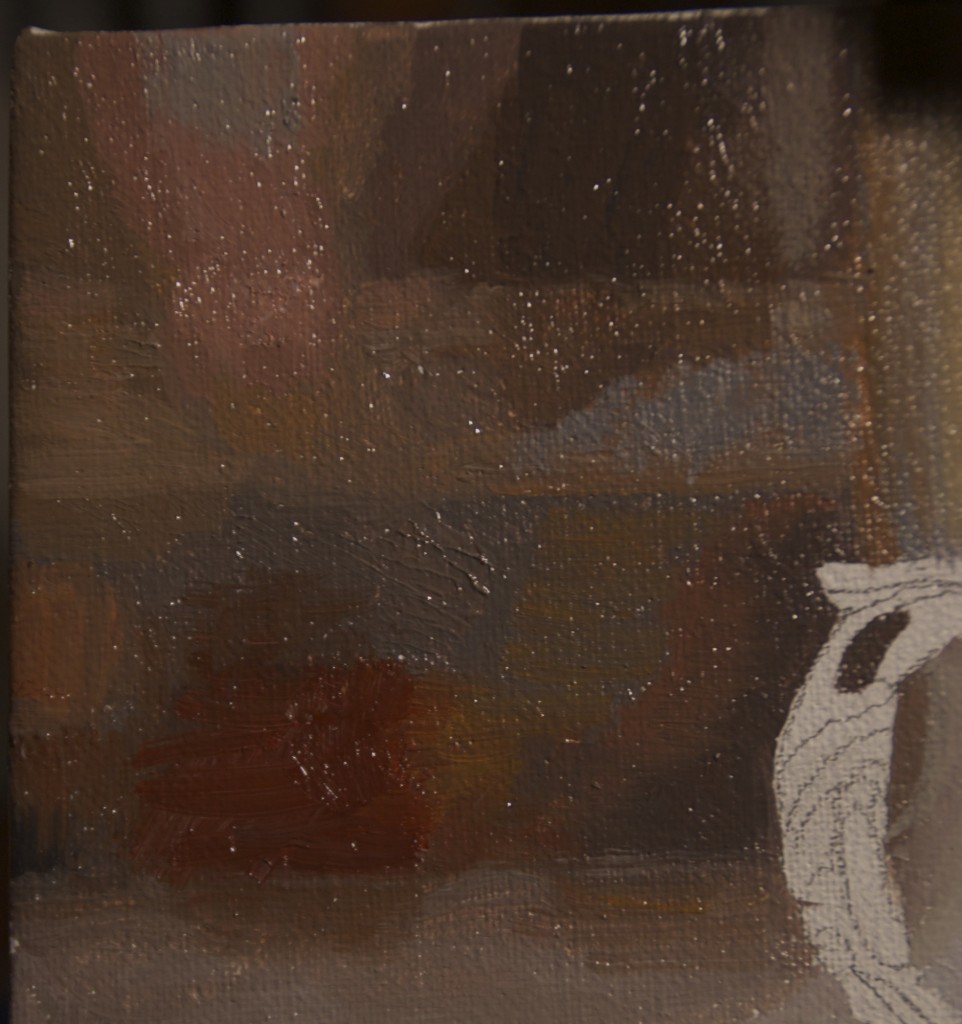
Detail of background, in progress, from my most recent still life
To continue the train of thought from my last post, I’m working on a modest still life, very simple, painting it at Goldilocks speed, not too rushed but not too cautious, either. If I can generalize an area of varied color into a single hue, I’ll do it, and save the detail work for later, or leave it, or I might linger as long as it takes on certain details. While I’ve been working on this painting, my mind has felt restfully attentive to the quality of the paint I’m applying as much as the image I’m trying to create. I’m working from a photograph I took of a small pewter sugar bowl in our kitchen, and I’m sticking to the narrow depth of field in the shot, which blurs the background slightly. It’s my version of photorealism, though it won’t pass for a photograph up close. I’m simply being straightforward about the artifacts of a shot taken at a certain aperture setting. I almost always use my own photography when I paint an image, sometimes working from multiple shots of a subject in order to get what I want. I had a conversation recently over lunch with Rick Harrington about visibly “pushing paint around.” Rick’s sense was that being faithful to a photograph was antithetical to his love of how paint feels as you apply it and how paint is what a painting is really about. Working from a photograph feels constraining to him, and takes his focus away from the paint itself. Clement Greenburg would approve. I went away feeling as if I disagreed, though not entirely, but without being able to pin down why the conversation left me ambivalent.
I’m happy if I’m working economically, getting more out of the paint than I seem to be putting into it. I keep the process as simple-minded and transparent as I can. The painters I usually respond to most enthusiastically show me exactly what was happening as the painter worked: everything seems to be there on the surface in Fairfield Porter or Neil Welliver or Jenny Saville, which makes the final result so much more remarkable when the image clicks into place, despite how little precise detail the painter is actually rendering. You can track their effort and you can see how they did what they did, though when you stand back you see more, it seems, than the effort they invested. There are no tricks in the magic act. It’s just paint on a surface, and yet it’s also a scene that evokes all sorts of reactions as you forget that it’s paint. The tension is there between seeing the paint and seeing the scene, and the more I can see how simply and directly the painter created the image, the more interesting the tension between paint and image becomes.
Sometimes, for me, this means being very true to the source MORE
November 4th, 2014 by dave dorsey
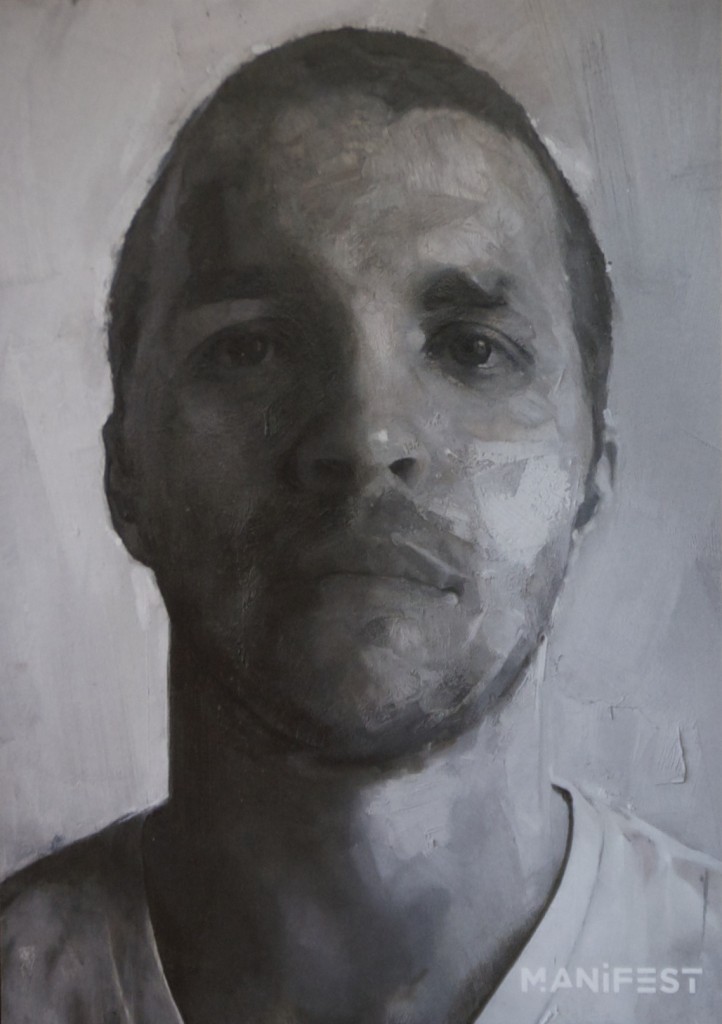
Face First. Reed Govert’s oil portrait in the current exhibit at Manifest.
I had lunch with a couple friends a couple weeks ago, one of them fellow painter Rick Harrington. We had an interesting discussion about the importance of paint. Two painters talking about paint. Shocking, isn’t it? Rick was expressing his feeling that working from photography inhibits him and has a tendency to turn his attention away from paint and more toward fidelity to the image, the effort of duplicating a camera’s lifeless, flat image. (I disagreed that this is what a camera always gives you, though it’s often true of landscape photography, and Rick paints mostly outdoor scenes and landscapes.) Behind his reservation was the commonly held assumption that working from a photograph becomes an effort to simply copy the photograph rather than using it as a starting point, a fixed reference for doing something based on it. Often that effort can be nothing more than capturing a hyper-realistic duplicate of what the photograph shows, but usually it means altering quite a bit of the shot in subtle ways, or even radical ways. And sometimes it means combining half a dozen shots into a single image. But Rick was right about how, while working from photography, there’s a temptation to slowly inch your way across a canvas, perfecting each square inch as a replica of the corresponding inch in the photograph. (I think there’s pleasure and there can be some big rewards in doing that, but I understand what he’s saying. That kind of slavish obedience to the photograph can rob the painting of life and energy.)
I kidded him about being a brushwork fascist, but I came away MORE




